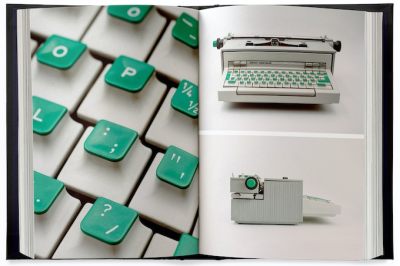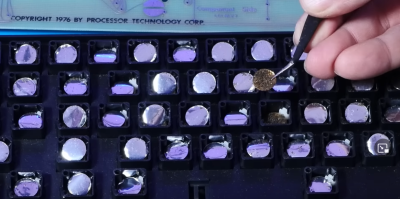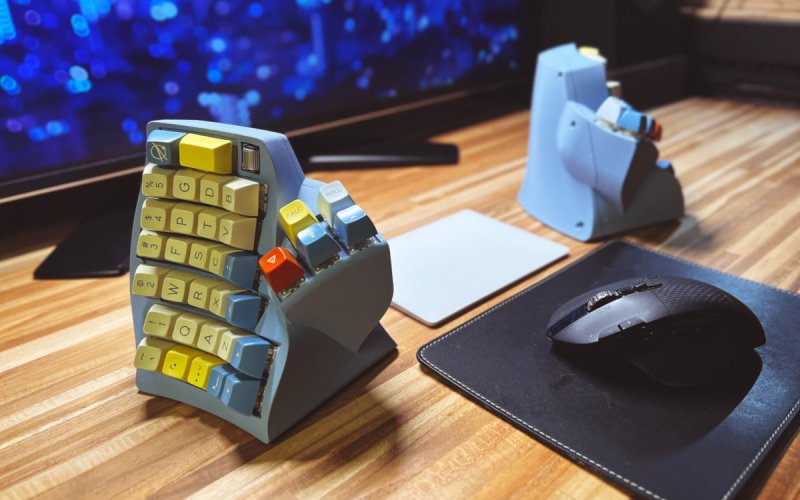

Hooray, the system works! [Sasha K.] wrote to let me know about their Thumbs Up! keyboard, which is the culmination of a long journey down the DIY rabbit hole to end game. (Seriously, it’s kind of a wild ride, and there’s a ton of pictures).

While the full split only comes in RP2040 (not that there’s anything wrong with that), the monoblock split is available in Pro Micro, ATmega Mini, and RP2040 versions. You can find the STL for the tilt stand and other goodies on Thingiverse.
The Shift Happens Campaign Is Live
They say everyone has a book in them, and they also say that you should write the book you want most to read. It has been a long time coming, but Marcin Wichary’s venerable 1200+ page tome entitled Shift Happens has reached the Kickstarter stage. I’m chuffed to see that it has already been funded 279% past the original $150K goal, which at $150 per handsome two-volume set, equaled out to only 1,000 copies. It would be a shame if the book turned out to be that rare.

While $150 may sound like a lot to spend on reading material, this is no mere set of books. Shift Happens represents all things keyboard, and quite indulgently so — just look at the photographs and imagine having those beauties on paper, in your home. Whether you’re into typewriters, mechanical keyboards, or just like industrial design and tech history, this is the labor of love we’ve been waiting for.
The Centerfold: Clavert 1873
I’m not sure what it is I like most about Clavert, which is a portmanteau of clavier and vertical. It has some really nice curves going on, which are uninterrupted by any keys larger than 1u. Even the encoder fits nicely with the 1u scheme, and the whole colorway is also fantastic. About the only thing we don’t like is [stvneads] aka [thlintw]’s assessment that handwiring is lame. Never! Handwiring is freedom!
Via KBD #112
Do you rock a sweet set of peripherals on a screamin’ desk pad? Send a picture to Damn Fine Keyboards along with your handle and all the gory details, and you could be featured there and here! Or send it to me directly!
Historical Clackers: The World Index Typewriter

Index typewriters, which print one character at a time in the manner of an old embossing label maker, were once great competitors of two-handed typewriters.
In the late 1880s, few people could touch-type anyway, and the World 1 index typewriter was a cheap and cheerful substitute that was quite small and portable to boot. With only 30 pieces to them, they weren’t too complicated to fix, either.
Two models were sold by a string of manufacturers — the No. 1, which produced only uppercase, and the No. 2 which stamped out both. A gushing article from 1887 stated that a skilled user could reach upwards of 80 WPM, which is hilarious to think about. Could anyone do anywhere near 80 WPM on a label maker? I think not.
ICYMI: Sol-20 Keyboard Repair

The solution? After using bare fingers to verify the PCB pads still sent key presses, they resolved to remove the remaining foam dust and glue from every key and replace it all with the foam-foil bits from a Sun 4 keyboard. But given that those switches aren’t that much younger, [Action Retro] was pleased to discover that there’s a company out there making brand new foam-and-foil replacement pads. However, it wasn’t a 100% drop-in fix — many keys repeated, and several didn’t work at all. After removing a bodge wire from an old key-repeat mod and cleaning the pads thoroughly, they got most of the way there. Check out the entire video, or jump right into the keyboard repair.
Got a hot tip that has like, anything to do with keyboards? Help me out by sending in a link or two. Don’t want all the Hackaday scribes to see it? Feel free to email me directly.



